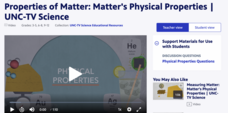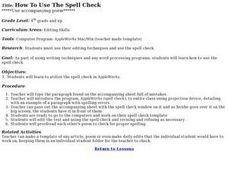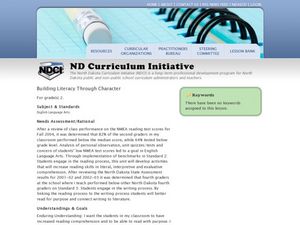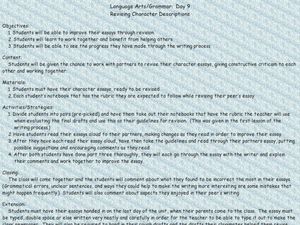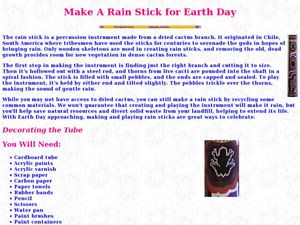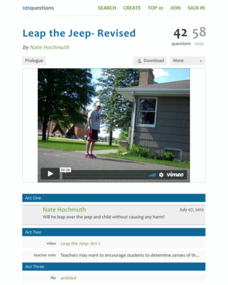National Park Service
What Can We Do?
Motivate young conservationists to stand up and make a change. After learning about the efforts in Cascade Nation Park to reduce carbon emissions in order to preserve the wilderness, students work in groups creating action plans for...
National Gallery of Canada
Picture This!
Introduce your class to Inuit prints and use these artworks as inspiration for a printmaking activity. Pupils make stories to go along with the images and then come up with their own heroic moments to illustrate. They take moments from...
University of North Carolina
Paragraph Development
There's no set length for a good paragraph, but the short block of text should contain key components. A handout on paragraphs, the 12th in a series of 24, outlines a five-step process for paragraph development. Additionally, the handout...
College Board
2000 AP® Environmental Science Free-Response Questions
Practice makes perfect! A released AP® exam gives scholars practice with the high level of expectations of their exams. The exam consists of four questions from 2000. Questions ask about endangered species, recycling, alternative fuels,...
College Board
2008 AP® Environmental Science Free-Response Questions
Some of the oiliest creatures on earth may be the answer to our energy crisis! Using a four-question assessment, resource scholars consider the use of microalgae as fuel among other environmental science topics. Each question has several...
PBS
Properties of Matter: Matter's Physical Properties | UNC-TV Science
Does gold really boil? Learn what temperature gold boils at and more using an animated activity about the properties of matter. Scientists learn about the properties of matter including examples of physical properties, the effect changes...
Curated OER
Writing a Biography - Part Three
Students edit and revise a first draft of an essay which they are in the process of writing. They proofread for grammatical, spelling, and punctuation errors while using their word processing skills.
Curated OER
How To Use The Spell Check
Pupils use their editing techniques and use the spell check on their computers using writing techniques and any word processing programs. Then they type the paragraph found on the accompanying sheet full of mistakes. Students also go...
Curated OER
You Can Judge a Book By Its Cover
Fifth graders explore the purpose for reading a piece of literature. In this reading lesson, 5th graders view the cover of a book and then predict the order of details from the book. Students listen to the piece of literature and...
Curated OER
Deductiva Deductions (Deductive Reasoning)
Third graders apply deductive reasoning and make predictions. In this language arts lesson, 3rd graders discuss questions and use deductive reasoning to make a prediction. Students look for patterns and prior knowledge to make predictions.
Curated OER
Building Literacy Through Character
Second graders connect reading to writing by making predictions, completing text to world connections, solving problems, and more. In this reading and writing lesson plan, 2nd graders draw conclusions after reading and write them down.
Purdue University
Sentence Fragments Exercise 2
In this sentence fragment exercise, learners are given paragraphs to proofread for sentence fragments. Students are given space to make revisions.
Curated OER
Revision Checklist
In this language arts worksheet, students go through the checklist in order to make revisions to writing samples before constructing a final draft.
Curated OER
Lesson Plan 18: Cleaning It Up
Careful proofreading is an important step in the writing process. After guided practice using a provided worksheet that details common grammar concepts, young writers refer to the worksheet as they proofread their own work....
Blinn College
The Writing Process
Lead your learners through the different stages of the writing process. Show them this presentation as they work through a writing assignment, breaking it up over several days of work. You might also post this on a class website as a...
Curated OER
Proofreading and Revising Articles for a Class Newsletter
Students submit their newsletter articles and a newsletter team proofreads them. Revisions are suggested. Writers revise their articles. Using a template from a word processing program, articles are typed in final form.
Curated OER
Revising Character Descriptions
Students effectively revise character descriptions. In this revising character descriptions lesson, students work with a partner to give and receive constructive criticism to improve their character descriptions.
Curated OER
Revising for Parallelism
In this parallelism worksheet, students revise 20 sentences to make its structure parallel. A sample is given at the top of the page.
Curated OER
General to Specific
Learners revise a recent draft of writing to make the content more specific. They trace their hands on a large sheet of paper. Students, in the palms of their traced hand print, write in the general topic of the writing draft. On the...
Curated OER
Revising Sentence Fragments
In this revising sentence fragments online worksheet, 6th graders rewrite 5 fragments, adding a subject, a predicate or both to make a complete sentence.
Curated OER
Revise for Parallel Structure
For this parallel structure worksheet, learners revise a set of 20 sentences for parallel structure. Page has links to additional resources.
Curated OER
Predicting: Making a Hypothesis
Middle schoolers analyze information from various sources to create a hypothesis about the origin of a family artifact. Students create a hypothesis about the origin of the item and write a paragraph explaining why they believe the...
Curated OER
Make a Rain Stick for Earth Day
Students construct rain sticks. For this ecology multicultural lesson, students use recyclable items to construct a rainstick. Detailed instructions for making and decorating the rainstick are given.
101 Questions
Leap the Jeep
Will harm come to the child in the video? Find out by modeling the scenario mathematically! Learners represent the situation with a quadratic model before deciding on a maximum height and time the person is in the air. Too low or not...







